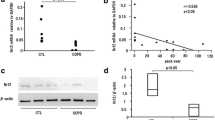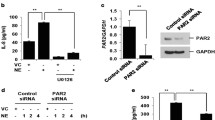Abstract
Background
Receptor for advanced glycation end products (RAGE), a multiple-ligands receptor, is implicated in chronic obstructive pulmonary disease (COPD). This study was designed to investigate the potential role of RAGE in nitric oxide (NO) generation, an endogenous marker of nitrosative stress in COPD.
Methods
Lung tissues from COPD patients were used to describe the relationship between RAGE expression and NO level. RAGE expression was assessed by immunohistochemistry, western blot, and ELISA. Human bronchial epithelial cells (16HBE) were cultured with cigarette smoke extract (CSE). Neutralizing antibody against RAGE was used to detect the role of RAGE in CSE-induced NO generation by 16HBE cells.
Results
Compared with nonsmoker controls, overexpression of RAGE was significantly detected in COPD smokers (p < 0.01), but not healthy smokers and nonsmokers with COPD, which was dominantly expressed at bronchiolar epithelia. Correlation analysis showed that RAGE in COPD smokers was positively related to NO level, smoking status, and lung function decline. In cultured 16HBE cells treated with CSE, soluble RAGE was reduced; however, full-length RAGE was enhanced significantly as the same trend as NO generation. Moreover, increased NO level and NO synthase activity, decreased total glutathione (a major cellular antioxidant), enhanced nuclear translocation of p65 (a key molecule of nuclear factor (NF)-κB) and release of NF-κB-dependent proinflammatory cytokines were all reversed by pretreatment of anti-RAGE antibody.
Conclusions
These findings suggest that overexpression of RAGE contributes to CS-induced NO generation in COPD with involvement in NF-κB activation.




Similar content being viewed by others
References
Ricciardolo FL, Caramori G, Ito K, Capelli A, Brun P, Abatangelo G, Papi A, Chung KF, Adcock I, Barnes PJ, Donner CF, Rossi A, Di Stefano A (2005) Nitrosative stress in the bronchial mucosa of severe chronic obstructive pulmonary disease. J Allergy Clin Immunol 116:1028–1035
MacNee W (2010) Oxidative stress and chronic obstructive pulmonary disease. Manag Chronic Obstr Pulm Dis 1:100–129
Ramasamy R, Vannucci SJ, Yan SSD, Herold K, Yan SF, Schmidt AM (2005) Advanced glycation end products and RAGE: a common thread in aging, diabetes, neurodegeneration, and inflammation. Glycobiology 15:16R–28R
Sumi D, Ignarro LJ (2004) Regulation of inducible nitric oxide synthase expression in advanced glycation end product–stimulated RAW 264.7 cells: the role of heme oxygenase-1 and endogenous nitric oxide. Diabetes 53:1841–1850
Rojas A, Figueroa H, Morales E (2010) Fueling inflammation at tumor microenvironment: the role of multiligand/rage axis. Carcinogenesis 31:334–341
He M, Kubo H, Ishizawa K, Hegab AE, Yamamoto Y, Yamamoto H, Yamaya M (2007) The role of the receptor for advanced glycation end-products in lung fibrosis. Am J Physiol Lung Cell Mol Physiol 293:L1427–L1436
Uchida T, Shirasawa M, Ware LB, Kojima K, Hata Y, Makita K, Mednick G, Matthay ZA, Matthay MA (2006) Receptor for advanced glycation end-products is a marker of type I cell injury in acute lung injury. Am J Respir Crit Care Med 173:1008–1015
Morbini P, Villa C, Campo I, Zorzetto M, Inghilleri S, Luisetti M (2006) The receptor for advanced glycation end products and its ligands: a new inflammatory pathway in lung disease? Mod Pathol 19:1437–1445
Wu L, Ma L, Nicholson LF, Black PN (2011) Advanced glycation end products and its receptor (RAGE) are increased in patients with COPD. Respir Med 105:329–336
Ferhani N, Letuve S, Kozhich A, Thibaudeau O, Grandsaigne M, Maret M, Dombret M, Sims GP, Kolbeck R, Coyle AJ, Aubier M, Pretolani M (2010) Expression of high-mobility group box 1 and of receptor for advanced glycation end products in chronic obstructive pulmonary disease. Am J Respir Crit Care Med 181:917–927
Reynolds PR, Kasteler SD, Schmitt RE, Hoidal JR (2011) Receptor for advanced glycation end-products signals through ras during tobacco smoke-induced pulmonary inflammation. Am J Respir Cell Mol Biol 45:411–418
Vayssier-Taussat M, Camilli T, Aron Y, Meplan C, Hainaut P, Polla BS, Weksler B (2001) Effects of tobacco smoke and benzo[a]pyrene on human endothelial cell and monocyte stress responses. Am J Physiol Heart Circ Physiol 280:H1293–H1300
Tabera S, Pérez-Simón JA, Díez-Campelo M, Sánchez-Abarca LI, Blanco B, López A, Benito A, Ocio E, Sánchez-Guijo FM, Cañizo C, San Miguel JF (2008) The effect of mesenchymal stem cells on the viability, proliferation and differentiation of B-lymphocytes. Haematologica 93:1301–1309
Chen L, Wang T, Zhang JY, Zhang SF, Liu DS, Xu D, Wang X, Chen YJ, Wen FQ (2009) Toll-like receptor 4 relates to lipopolysaccharide-induced mucus hypersecretion in rat airway. Arch Med Res 40:10–17
Liu DS, Liu WJ, Chen L, Ou XM, Wang T, Feng YL, Zhang SF, Xu D, Chen YJ, Wen FQ (2009) Rosiglitazone, a peroxisome proliferator-activated receptor-gamma agonist, attenuates acrolein-induced airway mucus hypersecretion in rats. Toxicology 260:112–119
Xiong J, Lu H, Lu K, Duan Y, An L, Zhu C (2009) Cadmium decreases crown root number by decreasing endogenous nitric oxide, which is indispensable for crown root primordia initiation in rice seedlings. Planta 230:599–610
Herold K, Moser B, Chen Y, Zeng S, Yan SF, Ramasamy R, Emond J, Clynes R, Schmidt AM (2007) Receptor for advanced glycation end products (RAGE) in a dash to the rescue: inflammatory signals gone awry in the primal response to stress. J Leukoc Biol 82:204–212
Ohlmeier S, Mazur W, Salmenkivi K, Myllärniemi M, Bergmann U, Kinnula VL (2010) Proteomic studies on receptor for advanced glycation end product variants in idiopathic pulmonary fibrosis and chronic obstructive pulmonary disease. Proteomics Clin Appl 4(1):97–105
Miniati M, Monti S, Basta G, Cocci F, Fornai E, Bottai M (2011) Soluble receptor for advanced glycation end products in COPD: relationship with emphysema and chronic cor pulmonale: a case-control study. Respir Res 30(12):37
Smith DJ, Yerkovich ST, Towers MA, Carroll ML, Thomas R, Upham JW (2011) Reduced soluble receptor for advanced glycation end-products in COPD. Eur Respir J 37(3):516–522
Sukkar MB, Wood LG, Tooze M, Simpson JL, McDonald VM, Gibson PG, Wark PA (2012) Soluble RAGE is deficient in neutrophilic asthma and COPD. Eur Respir J 39:721–729
Zhang S, Xu N, Nie J, Dong L, Li J, Tong J (2008) Proteomic alteration in lung tissue of rats exposed to cigarette smoke. Toxicol Lett 178:191–196
Liu Y, Ma Y, Wang R, Xia C, Zhang R, Lian K, Luan R, Sun L, Yang L, Lau WB, Wang H, Tao L (2011) Advanced glycation end products accelerate ischemia/ reperfusion injury through receptor of advanced end product/nitrative thioredoxin inactivation in cardiac microvascular endothelial cells. Antioxid Redox Signal 15:1769–1778
Vincent AM, Perrone L, Sullivan KA, Backus C, Sastry AM, Lastoskie C, Feldman EL (2007) Receptor for advanced glycation end products activation injures primary sensory neurons via oxidative stress. Endocrinology 148:548–558
Kamioka M, Ishibashi T, Ohkawara H, Nagai R, Sugimoto K, Uekita H, Matsui T, Yamagishi S, Ando K, Sakamoto T, Sakamoto N, Takuwa Y, Wada I, Shiomi M, Maruyama Y, Takeishi Y (2011) Involvement of membrane type 1-matrix metalloproteinase (MT1-MMP) in RAGE activation signaling pathways. J Cell Physiol 226:1554–1563
Marshall HE, Merchant K, Stamler JS (2000) Nitrosation and oxidation in the regulation of gene expression. FASEB J 14:1889–1900
Yoshida T, Tuder RM (2007) Pathobiology of cigarette smoke-induced chronic obstructive pulmonary disease. Physiol Rev 87:1047–1082
Chen L, Liu L, Wang T, Shen YC, Wen FQ (2013) Receptor for advanced glycation end products: a new therapeutic target for chronic obstructive pulmonary disease? Arch Med Res 44(1):75–76
Acknowledgments
This study was supported in part by Grants 81200031, 31000513, 31171103, and 81230001 from the National Natural Science Foundation of China and Grant 06-834 from the China Medical Board of New York.
Conflict of interest
None.
Author information
Authors and Affiliations
Corresponding author
Additional information
Lei Chen, Tao Wang, and Lingli Guo have contributed equally to this study.
Electronic supplementary material
Below is the link to the electronic supplementary material.
Rights and permissions
About this article
Cite this article
Chen, L., Wang, T., Guo, L. et al. Overexpression of RAGE Contributes to Cigarette Smoke-Induced Nitric Oxide Generation in COPD. Lung 192, 267–275 (2014). https://doi.org/10.1007/s00408-014-9561-1
Received:
Accepted:
Published:
Issue Date:
DOI: https://doi.org/10.1007/s00408-014-9561-1




